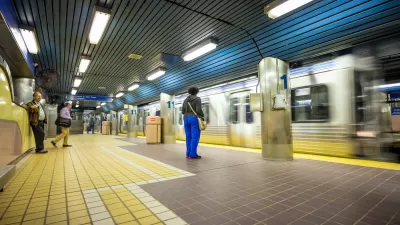A new report by the Pew Charitable Trusts tracks the demographics of Philadelphia between 1970 and 2010. Overall, middle class residents left the city during those decades, but there are reasons for optimism regarding the prosperity of the city.
A recent report by the Pew Charitable Trusts finds that the city of Philadelphia’s middle class shrank between 1970 and 2010, simultaneous with a growing proportion of impoverished residents.
“The Philadelphia middle class, a backbone of economic vitality that once made up the majority of residents in most of the city's neighborhoods, has declined in steep numbers since 1970, from 59 percent to 42 percent by 2010,” according to an article by Maria Panaritis detailing the report. Moreover “the share of lower-class Philadelphians spiked from 30 percent to 47 percent as the middle class shrank.”
Panaritis also compares Philadelphia’s demographic shift relative to other cities around the country. “Philadelphia is decidedly poorer than when it was a manufacturing powerhouse, losing even a greater share of higher-taxpaying middle-class residents than the nation as a whole, and failing even to see increases in its upper-class population to match other cities that fared better.”
In article announcing the report, Pew provides a less gloomy take on the study: “The size of Philadelphia’s middle class has essentially stabilized in the past decade after a period of prolonged decline.”
Moreover, the middle class that currently lives in the city is better off than the middle class 40 years go: “Today’s middle-class Philadelphians are better educated and more likely to work in professional or service jobs than their counterparts of four decades ago and other city residents now.”
FULL STORY: Pew report: City's middle class is shrinking

Alabama: Trump Terminates Settlements for Black Communities Harmed By Raw Sewage
Trump deemed the landmark civil rights agreement “illegal DEI and environmental justice policy.”

Planetizen Federal Action Tracker
A weekly monitor of how Trump’s orders and actions are impacting planners and planning in America.

Why Should We Subsidize Public Transportation?
Many public transit agencies face financial stress due to rising costs, declining fare revenue, and declining subsidies. Transit advocates must provide a strong business case for increasing public transit funding.

Understanding Road Diets
An explainer from Momentum highlights the advantages of reducing vehicle lanes in favor of more bike, transit, and pedestrian infrastructure.

New California Law Regulates Warehouse Pollution
A new law tightens building and emissions regulations for large distribution warehouses to mitigate air pollution and traffic in surrounding communities.

Phoenix Announces Opening Date for Light Rail Extension
The South Central extension will connect South Phoenix to downtown and other major hubs starting on June 7.
Urban Design for Planners 1: Software Tools
This six-course series explores essential urban design concepts using open source software and equips planners with the tools they need to participate fully in the urban design process.
Planning for Universal Design
Learn the tools for implementing Universal Design in planning regulations.
Caltrans
Smith Gee Studio
Institute for Housing and Urban Development Studies (IHS)
City of Grandview
Harvard GSD Executive Education
Toledo-Lucas County Plan Commissions
Salt Lake City
NYU Wagner Graduate School of Public Service




























